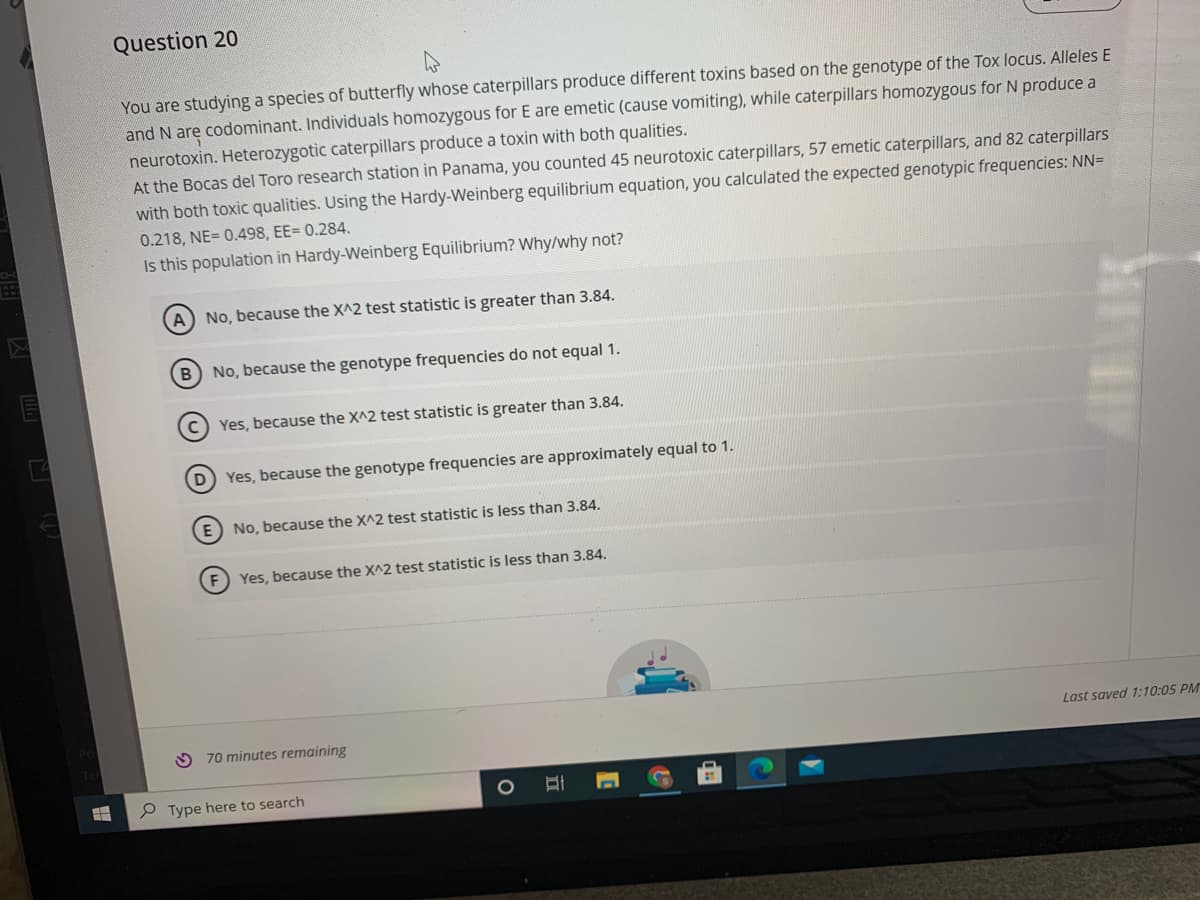Question 20 You are studying a species of butterfly whose caterpillars produce different toxins based on the genotype of the Tox locus. Alleles E and N are codominant. Individuals homozygous for E are emetic (cause vomiting), while caterpillars homozygous for N produce a neurotoxin. Heterozygotic caterpillars produce a toxin with both qualities. At the Bocas del Toro research station in Panama, you counted 45 neurotoxic caterpillars, 57 emetic caterpillars, and 82 caterpillars with both toxic qualities. Using the Hardy-Weinberg equilibrium equation, you calculated the expected genotypic frequencies: NN= 0.218, NE= 0.498, EE= 0.284. Is this population in Hardy-Weinberg Equilibrium? Why/why not? A No, because the X^2 test statistic is greater than 3.84. B No, because the genotype frequencies not equal 1. Yes, because the X^2 test statistic is greater than 3.84. D Yes, because the genotype frequencies are approximately equal to 1. E) No, because the X^2 test statistic is less than 3.84. F) Yes, because the X^2 test statistic is less than 3.84.
Question 20 You are studying a species of butterfly whose caterpillars produce different toxins based on the genotype of the Tox locus. Alleles E and N are codominant. Individuals homozygous for E are emetic (cause vomiting), while caterpillars homozygous for N produce a neurotoxin. Heterozygotic caterpillars produce a toxin with both qualities. At the Bocas del Toro research station in Panama, you counted 45 neurotoxic caterpillars, 57 emetic caterpillars, and 82 caterpillars with both toxic qualities. Using the Hardy-Weinberg equilibrium equation, you calculated the expected genotypic frequencies: NN= 0.218, NE= 0.498, EE= 0.284. Is this population in Hardy-Weinberg Equilibrium? Why/why not? A No, because the X^2 test statistic is greater than 3.84. B No, because the genotype frequencies not equal 1. Yes, because the X^2 test statistic is greater than 3.84. D Yes, because the genotype frequencies are approximately equal to 1. E) No, because the X^2 test statistic is less than 3.84. F) Yes, because the X^2 test statistic is less than 3.84.
Human Anatomy & Physiology (11th Edition)
11th Edition
ISBN:9780134580999
Author:Elaine N. Marieb, Katja N. Hoehn
Publisher:Elaine N. Marieb, Katja N. Hoehn
Chapter1: The Human Body: An Orientation
Section: Chapter Questions
Problem 1RQ: The correct sequence of levels forming the structural hierarchy is A. (a) organ, organ system,...
Related questions
Topic Video
Question

Transcribed Image Text:Question 20
You are studying a species of butterfly whose caterpillars produce different toxins based on the genotype of the Tox locus. Alleles E
and N are codominant. Individuals homozygous for E are emetic (cause vomiting), while caterpillars homozygous for N produce a
neurotoxin. Heterozygotic caterpillars produce a toxin with both qualities.
At the Bocas del Toro research station in Panama, you counted 45 neurotoxic caterpillars, 57 emetic caterpillars, and 82 caterpillars
with both toxic qualities. Using the Hardy-Weinberg equilibrium equation, you calculated the expected genotypic frequencies: NN=
0.218, NE= 0.498, EE= 0.284.
Is this population in Hardy-Weinberg Equilibrium? Why/why not?
A) No, because the X^2 test statistic is greater than 3.84.
B) No, because the genotype frequencies do not equal 1.
c) Yes, because the X^2 test statistic is greater than 3.84.
D Yes, because the genotype frequencies are approximately equal to 1.
E) No, because the X^2 test statistic is less than 3.84.
F) Yes, because the X^2 test statistic is less than 3.84.
Last saved 1:10:05 PM
70 minutes remaining
P Type here to search
Expert Solution
This question has been solved!
Explore an expertly crafted, step-by-step solution for a thorough understanding of key concepts.
Step by step
Solved in 2 steps

Knowledge Booster
Learn more about
Need a deep-dive on the concept behind this application? Look no further. Learn more about this topic, biology and related others by exploring similar questions and additional content below.Recommended textbooks for you

Human Anatomy & Physiology (11th Edition)
Biology
ISBN:
9780134580999
Author:
Elaine N. Marieb, Katja N. Hoehn
Publisher:
PEARSON

Biology 2e
Biology
ISBN:
9781947172517
Author:
Matthew Douglas, Jung Choi, Mary Ann Clark
Publisher:
OpenStax

Anatomy & Physiology
Biology
ISBN:
9781259398629
Author:
McKinley, Michael P., O'loughlin, Valerie Dean, Bidle, Theresa Stouter
Publisher:
Mcgraw Hill Education,

Human Anatomy & Physiology (11th Edition)
Biology
ISBN:
9780134580999
Author:
Elaine N. Marieb, Katja N. Hoehn
Publisher:
PEARSON

Biology 2e
Biology
ISBN:
9781947172517
Author:
Matthew Douglas, Jung Choi, Mary Ann Clark
Publisher:
OpenStax

Anatomy & Physiology
Biology
ISBN:
9781259398629
Author:
McKinley, Michael P., O'loughlin, Valerie Dean, Bidle, Theresa Stouter
Publisher:
Mcgraw Hill Education,

Molecular Biology of the Cell (Sixth Edition)
Biology
ISBN:
9780815344322
Author:
Bruce Alberts, Alexander D. Johnson, Julian Lewis, David Morgan, Martin Raff, Keith Roberts, Peter Walter
Publisher:
W. W. Norton & Company

Laboratory Manual For Human Anatomy & Physiology
Biology
ISBN:
9781260159363
Author:
Martin, Terry R., Prentice-craver, Cynthia
Publisher:
McGraw-Hill Publishing Co.

Inquiry Into Life (16th Edition)
Biology
ISBN:
9781260231700
Author:
Sylvia S. Mader, Michael Windelspecht
Publisher:
McGraw Hill Education